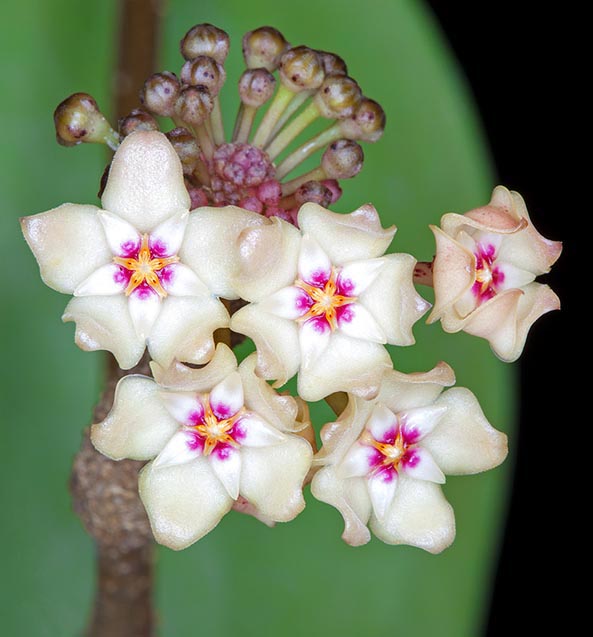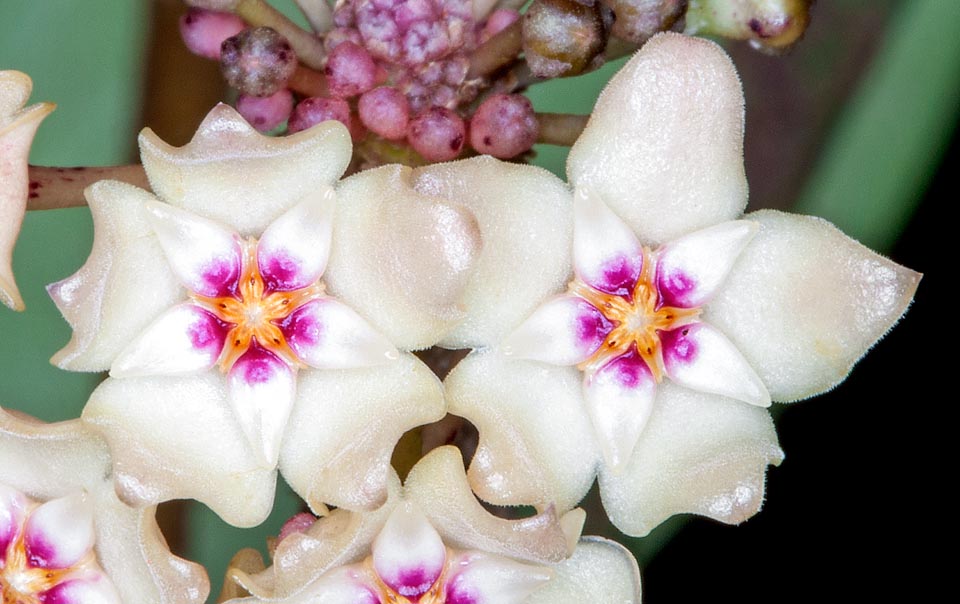Family : Apocynaceae

Text © Pietro Puccio

English translation by Mario Beltramini
The species is native to Brunei, Cambodia, Eastern India, Indonesia (Borneo, Java, Sulawesi and Sumatra), Laos, Myanmar, Peninsular Malaysia, Singapore and Thailand where it grows mainly in the forests of Dipterocarpaceae as epiphyte on the branches of the trees or on the rocks, from the sea level up to about 900 m of altitude.
The genus is honoured to Thomas Hoy (ca. 1750-1822), botanist and curator of the gardens of the Duke of Northumberland; the specific name is the Latin adjective “verticillatus, a, um” = verticillate, with reference to the leaves arranged (rarely) in verticils of four.

The Hoya verticillata is a climbing epiphyte of the forests of Dipterocarpaceae of South-East Asia © Giuseppe Mazza
The Hoya verticillata (Vahl) G. Don (1837) is an evergreen epiphytic climber, very variable as dimensions and shape of the leaves, with ramified stems and leaves, on a 0,5-3 cm long petiole, opposite, rarely in verticils of four, ovate-elliptic to oblong with acuminate apex and entire margin, fleshy, glabrous, 5-18 cm long and 3-10 cm broad.
Erect axillar umbel inflorescences, on a 3-5 cm long peduncle, bearing up to 70 flowers, of 1,2-1,8 cm of diameter, lasting about 5 days on the plant; the peduncles are persistent and can bloom again, therefore they are not to be cut after the blooming.
Cream white corolla with 5 ovate-triangular lobes with pointed apex, backward curved (revolute) margins, possibly with sparse tiny hairs above, and crown with ovate segments with white pointed apex having a pink base; the flowers emit an intense fragrance.
The fruits are follicles, 10-18 cm long and of 0,4 cm of diameter, containing numerous seeds provided with a tuft of silky hairs that favour their dispersion with the wind.
It reporoduces by seed, but usually by cutting, with 2-3 nodes, in draining and areated loam maintained humid at the temperature of 26-28 °C; it easily roots also in water.
Very discussed species from the taxonomical point of view due to the great variability consequent to the extended area of origin and diversity of ambiental conditions, the aforementioned characteristics are those on which there is agreement among the scholars in considering them as falling within the intrinsic variability.
Of easy cultivation, it is utilizable in open air in the tropical and subtropical climate zones in very luminous position, from filtered sun light to slight shade, elsewhere it can be cultivated in pot, climbing on appropriate supports or as drooping (suspended), to be sheltered in a protected location with high luminosity, also some hours of direct sun in the morning in winter, and very porous and draining substratum, rich of organic substance, neutral or slightly acidic.

Umbel inflorescences with even 70 flowers, very perfumed, of 1,2-1,8 cm of diameter lasting about 5 days. Of easy cultivation © Giuseppe Mazza
Synonyms: Sperlingia verticillata Vahl (1810).
→ To appreciate the biodiversity within the APOCYNACEAE family please click here.
